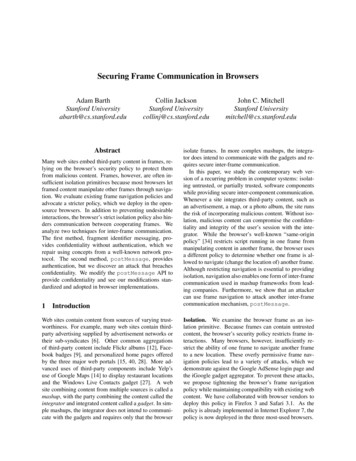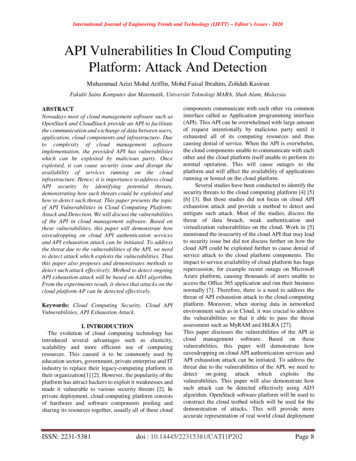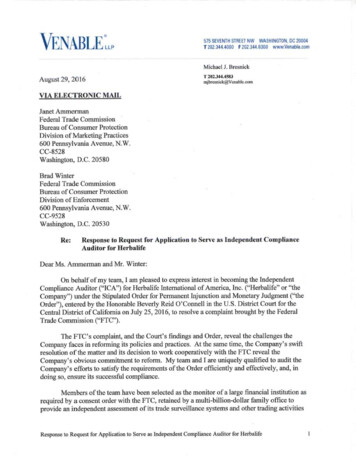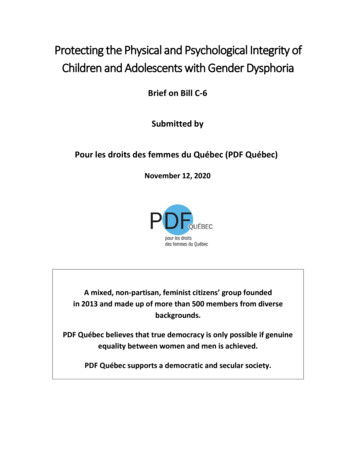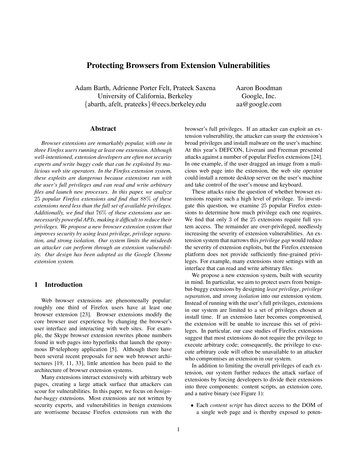
Transcription
Protecting Browsers from Extension VulnerabilitiesAdam Barth, Adrienne Porter Felt, Prateek SaxenaUniversity of California, Berkeley{abarth, afelt, prateeks}@eecs.berkeley.eduAbstractbrowser’s full privileges. If an attacker can exploit an extension vulnerability, the attacker can usurp the extension’sbroad privileges and install malware on the user’s machine.At this year’s DEFCON, Liverani and Freeman presentedattacks against a number of popular Firefox extensions [24].In one example, if the user dragged an image from a malicious web page into the extension, the web site operatorcould install a remote desktop server on the user’s machineand take control of the user’s mouse and keyboard.These attacks raise the question of whether browser extensions require such a high level of privilege. To investigate this question, we examine 25 popular Firefox extensions to determine how much privilege each one requires.We find that only 3 of the 25 extensions require full system access. The remainder are over-privileged, needlesslyincreasing the severity of extension vulnerabilities. An extension system that narrows this privilege gap would reducethe severity of extension exploits, but the Firefox extensionplatform does not provide sufficiently fine-grained privileges. For example, many extensions store settings with aninterface that can read and write arbitrary files.We propose a new extension system, built with securityin mind. In particular, we aim to protect users from benignbut-buggy extensions by designing least privilege, privilegeseparation, and strong isolation into our extension system.Instead of running with the user’s full privileges, extensionsin our system are limited to a set of privileges chosen atinstall time. If an extension later becomes compromised,the extension will be unable to increase this set of privileges. In particular, our case studies of Firefox extensionssuggest that most extensions do not require the privilege toexecute arbitrary code; consequently, the privilege to execute arbitrary code will often be unavailable to an attackerwho compromises an extension in our system.In addition to limiting the overall privileges of each extension, our system further reduces the attack surface ofextensions by forcing developers to divide their extensionsinto three components: content scripts, an extension core,and a native binary (see Figure 1):Browser extensions are remarkably popular, with one inthree Firefox users running at least one extension. Althoughwell-intentioned, extension developers are often not securityexperts and write buggy code that can be exploited by malicious web site operators. In the Firefox extension system,these exploits are dangerous because extensions run withthe user’s full privileges and can read and write arbitraryfiles and launch new processes. In this paper, we analyze25 popular Firefox extensions and find that 88% of theseextensions need less than the full set of available privileges.Additionally, we find that 76% of these extensions use unnecessarily powerful APIs, making it difficult to reduce theirprivileges. We propose a new browser extension system thatimproves security by using least privilege, privilege separation, and strong isolation. Our system limits the misdeedsan attacker can perform through an extension vulnerability. Our design has been adopted as the Google Chromeextension system.1Aaron BoodmanGoogle, Inc.aa@google.comIntroductionWeb browser extensions are phenomenally popular:roughly one third of Firefox users have at least onebrowser extension [23]. Browser extensions modify thecore browser user experience by changing the browser’suser interface and interacting with web sites. For example, the Skype browser extension rewrites phone numbersfound in web pages into hyperlinks that launch the eponymous IP-telephony application [5]. Although there havebeen several recent proposals for new web browser architectures [19, 11, 33], little attention has been paid to thearchitecture of browser extension systems.Many extensions interact extensively with arbitrary webpages, creating a large attack surface that attackers canscour for vulnerabilities. In this paper, we focus on benignbut-buggy extensions. Most extensions are not written bysecurity experts, and vulnerabilities in benign extensionsare worrisome because Firefox extensions run with the Each content script has direct access to the DOM ofa single web page and is thereby exposed to poten1
AttackerFigure 1. Extensions are divided into three components, each with progressively more privileges andless exposure to malicious web content.Our extension system design has been adopted byGoogle Chrome and is available in Google Chrome 4. Although it is difficult to predict how developers will use theextension system, we believe that this architecture will provide a solid foundation for building more secure extensions.tially malicious input. However, content scripts haveno other privileges except for the ability to send messages to the extension core. The extension core contains the bulk of the extensionprivileges, but the extension core can only interactwith web content via XMLHttpRequest and contentscripts. Even the extension core does not have directaccess to the host machine.2Attacks on ExtensionsA browser extension is a third-party software modulethat extends the functionality of a web browser, letting userscustomize their browsing experience. Because extensionsinteract directly with untrusted web content, extensions areat risk of attack from malicious web site operators and active network attackers. In this section, we present a genericthreat model for extension security that applies to both theFirefox extension system and the new extension system weintroduce in this paper. We then focus our attention on theFirefox extension system, providing background materialand examples of real attacks. An extension can optionally include a native binarythat can access the host machine with the user’s fullprivileges. The native binary interacts with the extension core via the standard NPAPI interface used byFlash and other browser plug-ins.To gain the user’s full privileges, an attacker would needto convince the extension to forward malicious input fromthe content script to the extension core and from the extension core to the native binary, where the input would needto exploit a vulnerability. We argue that exploiting such amulti-layer vulnerability is more difficult than exploiting asimple cross-site scripting hole in a Firefox extension.Finally, the different components of an extension are isolated from each other by strong protection boundaries: eachcomponent runs in a separate operating system process. Thecontent script and the extension core run in sandboxed processes that cannot use most operating system services. Asa first layer of defense, the content script is isolated fromits associated web page by running in a separate JavaScriptheap. Although both the content script and the web pagehave access to the same underlying DOM, the two never exchange JavaScript pointers, helping prevent JavaScript capability leaks [12].2.1Threat ModelWe focus on benign-but-buggy extensions: we assumethe extension developer is well-intentioned but not a security expert. The attacker attempts to corrupt the extensionand usurp its privileges. For example, the attacker mightbe able to install malware on the user’s machine if the extension has arbitrary file access. We assume the attacker isunable to entice the user into downloading or running native executables. We further assume the browser itself isvulnerability-free, letting us focus on the additional attacksurface provided by extensions.2
Replacing Native APIs. A malicious web page canconfuse (and ultimately exploit) a browser extensionby replacing native DOM APIs with methods of itsown definition. These fake methods might superficially behave like the native methods [9] and trickan extension into performing some misdeed. Tohelp mitigate this class of attack, Firefox automatically wraps references to untrusted objects with anXPCNativeWrapper. An XPCNativeWrapperis analogous to X-ray goggles: viewing a JavaScriptobject through an XPCNativeWrapper shows theunderlying native object, ignoring any modificationsmade by the page’s JavaScript. However, this securitymechanism has had a long history of implementationbugs [4, 3, 1]. Recent work has demonstrated that thesebugs are exploitable in some extensions [24].We consider two related threat models: a web attackerand an active network attacker. The web attacker controls aweb site, canonically https://attacker.com/, thatthe user visits. (Note that we do not assume that the userconfuses the attacker’s web site with another web site.) Typically, the attacker attempts to corrupt an extension when theextension interacts with the attacker’s web site. In additionto the abilities of a web attacker, an active network attackercan intercept, modify, and inject network traffic (e.g., HTTPresponses). The active network attacker threat model is appropriate, e.g., for a wireless network in a coffee shop.Plug-ins. In this paper, we focus on browser extensions,which differ from browser plug-ins. Plug-ins render specificmedia types (such as PDF and Flash) or expose additionalAPIs to web content (such as the Gears APIs). Plug-ins arerequested explicitly by web sites, usually by loading content with a specific MIME type. By way of contrast, extensions interact with web pages without their explicit consent. Although plug-in security is an important area of research [19, 18], securing browser extensions requires different techniques.2.2 JavaScript Capability Leaks. JavaScript capabilityleaks [12] are another avenue for exploiting extensions. If an extension leaks one of its own objects toa malicious web page, the attacker can often accessother JavaScript objects, including powerful extensionAPIs. For example, an early version of Greasemonkeyexposed a privileged version of XMLHttpRequestto every web page [34], letting attackers circumventthe browser’s same-origin policy by issuing HTTP requests with the user’s cookies to arbitrary web sitesand reading back the responses.Exploiting Firefox ExtensionsIn Firefox, browser extensions run with the same privileges as the browser itself. Firefox extensions have full access to browser internals and the user’s operating system.Extensions can change the functionality of the browser,modify the behavior of web sites, run arbitrary code, andaccess the file system. Firefox extensions combine two dangerous qualities: high privilege and rich interaction with untrusted web content. Taken together, these qualities risk exposing powerful privileges to attackers. We describe fourclasses of attacks against browser extensions and the relevant mitigations provided by the Firefox extension system: Mixed Content. An active network attacker can control content loaded via HTTP. The most severe formof this attack occurs when a browser extension loadsa script over HTTP and runs it. The attacker can replace this script and hijack the extension’s privilegesto install malware. A similar, but less powerful, attackoccurs when an extension injects an HTTP script intoan HTTPS page. For example, we discovered that anextension [6] injects an HTTP script into the HTTPSversion of Gmail. (We reported this vulnerability tothe developers of the extension on August 12, 2009,and the developers released a fixed version thereafter.) Cross-Site Scripting. Extension cross-site scripting (XSS) vulnerabilities result from interacting directly with untrusted web content. For example, if anextension uses eval or document.write withoutsanitizing the input, the attacker might be able to inject a script into the extension. In one recent example [24], a popular RSS aggregation extension evaluated data from the description element of anarbitrary web site without proper sanitization. To helpmitigate XSS attacks, Firefox provides a sandbox API,evalInSandbox. When evaluating a script usingevalInSandbox, the script runs without the extension’s privileges, thereby preventing the script fromcausing much harm. However, use of this sandboxevaluation is discretionary and does not cover everykind of interaction with untrusted content.Even though we might be able to design defenses for eachof these attack classes, we argue that the underlying issue isthat Firefox extensions interact directly with untrusted content while possessing a high level of privilege.3Limiting Firefox Extension PrivilegesA natural approach to mitigating extension vulnerabilities is to reduce the privileges granted to extensions. Toevaluate the feasibility of this approach, we studied 25 popular Firefox extensions to determine how much privilege3
/012*3* #,-*.*!"# %&'(6470()(8(345()(*# ,(/012(-.()(!"# %&'()*(a) Most powerful behavior.(b) Most powerful interface.Figure 2. The chart on the left shows the severity ratings of the most dangerous behaviors exhibitedby each extension. The chart on the right shows the security ratings of the extension interfaces usedto implement these behaviors.each needs to implement its features. In addition to presenting our case studies, we also present an algorithm forfinding methods in the Firefox extension API that lead froma less-privileged interface to a more-privileged interface.3.1source code. (This methodology under-approximates the setof interfaces.) We then manually correlated the interfaceswith the extensions’ functionality. This process could notbe automated because understanding high-level functionality requires human judgement.To compare the set of interfaces with extension functionality, we assigned one of five ratings (critical, high, medium,low, and none) to each interface and functionality based onthe Firefox Security Severity Ratings [8]:Case StudiesWe review 25 extensions manually to determine theirprivilege requirements: Critical: Can run arbitrary code on the user’s system(e.g., arbitrary file access)1. We analyze the behavior of an extension to determinehow much privilege an extension needs to realize itsfunctionality, letting us compare its required privilegesto its actual privileges. High: Can access site-specific confidential information (e.g., cookies and password) or the Document Object Model (DOM) of all web pages2. We analyze the implementation of an extension to determine how much power the extension receives, giventhe set of interfaces it uses to realize its functionality.This lets us evaluate how much we could reduce itsprivileges if we limited access to interfaces. Medium: Can access private user data (e.g., recent history) or the DOM of specific web pages Low: Can annoy the userWe find that most extensions do not require arbitrary filesystem access (the most powerful privilege), meaning thatmost extensions are over-privileged. We also find that extensions commonly use powerful interfaces to accomplishsimple tasks because the Firefox APIs are coarse-grained. None: No security privileges (e.g., a string) or privileges limited to the extension itselfResults. Of the 25 subject extensions, only 3 require critical privileges (see Figure 2(a)). Therefore, 22 of the subjectextensions are over-privileged because all extensions havethe privilege to perform critical tasks. Despite the fact thatonly 3 need critical privileges, 19 use a critical-rated interface (see Figure 2(b)). An additional 3 use high-ratedinterfaces despite needing only medium or less privileges,meaning that a total of 19 extensions use interfaces that havebroader privileges than they require. Figure 3 shows the detailed results. We summarize these results below:Methodology. We randomly selected two extensionsfrom each of the 13 categories in the “recommended” section of the Firefox Add-on directory. (See Appendix A fora list.) We excluded one of the selected extensions becauseit was distributed only as a binary. We verified that the 25subject extensions were also highly ranked in the “popular” directory. To determine the extensions’ functionality,we ran each extension and manually exercised its user interface. We also located usage of the extension system APIby searching for explicit interface names in the extensions’ Three extensions, all download managers, require theability to create new processes. (These are the only4
BehaviorProcess launching (C)User chooses a file (N)Extension-specific files (N)Extension-specific SQLite (N)Arbitrary network access (H)Specific domain access (M)Arbitrary DOM access (H)Page for display only (L)DOM of specific sites (M)Highlighted text/images (L)Password, login managers (H)Cookie manager (H)Same-extension prefs (N)Language preferences (M)InterfaceProcess launching (C)Arbitrary file access (C)Arbitrary file access (C)Arbitrary SQLite access (H)Arbitrary network access (H)Arbitrary network access (H)Arbitrary DOM access (H)Arbitrary DOM access (H)Arbitrary DOM access (H)Arbitrary DOM access (H)Password, login managers (H)Cookie manager (H)Browser & all ext prefs (H)Browser & all ext prefs Frequency3 (12%)11 (44%)10 (40%)3 (12%)8 (40%)2(8%)9 (36%)3 (12%)2(8%)2(8%)3 (12%)2(8%)21 (84%)1(4%)Figure 3. The frequency of security-relevant behaviors. The security rating of each behavior is abbreviated in parentheses. If the interface’s privilege is greater than the required behavioral privilege,there is a disparity.Unfortunately, reducing the privileges of extensions inthe Firefox extensions system is difficult because the Firefox extension API bundles many privileges into a singleinterface. This is evidenced by the 19 extensions that useexcessively powerful interfaces: 16 use critical-rated interfaces and 3 use high-rated interfaces without needingthat level of privilege. For example, most extensions usethe preference service to store extension-local preferences.This service can also change browser-wide preferences andpreferences belonging to other extensions.We identified the file system interface as a common pointof excessive privileges. Most extensions use the file systeminterface, which can read and write arbitrary files. Theseextensions could make use of lower-privilege file storageinterfaces if such interfaces existed. For example, 11 of theextensions could be limited to files selected by the user viaa file open dialog (analogous to the HTML file upload control), and 10 extensions could be limited to an extensionlocal persistent store (like the HTML 5 localStorageAPI) or an extension-specific directory. The download managers could also be limited to the downloads folder.three extensions that actually require critical privileges.) One extension converts file types using systemutilities, another runs a user-supplied virus scanner ondownloaded files, and the third launches a new processto use the operating system’s shutdown command. None of the extensions we studied require arbitrary fileaccess. Several extensions access files selected by afile open dialog, and most use files to store extensionlocal data. The download managers interact with filesas they are downloaded. 17 extensions require network access (e.g., observingnetwork data) and/or web page access (e.g., manipulating a page’s DOM). 10 require network access and11 require access to web pages. Of the 10 extensionsthat require network access, 2 require access only to aspecific set of origins. Nearly all of the extensions require access to anextension-local preference store to persist their ownpreferences, but only one changes global browser preferences (to switch languages).3.2Discussion. Although every Firefox extension runs withthe user’s full privileges, only three of the extensions weanalyze actually require these privileges. The remaining 22extensions exhibit a privilege gap: they run with more privileges than required. Moreover, none of the extensions require arbitrary file access and only 70% require network orweb pag
mitigate XSS attacks, Firefox provides a sandbox API, evalInSandbox. When evaluating a script using evalInSandbox, the script runs without the exten-sion’s privileges, thereby preventing the script from causing much harm. However, use of this sandbox evaluation is discretionary and does no
